

24th April 2025 (12 Topics)
Mains Issues
Context
Following the deadly terrorist attack took place in Pahalgam, Jammu and Kashmir, the Cabinet Committee on Security (CCS), India’s apex security decision-making body, took strong diplomatic steps against Pakistan, which is alleged to support terror groups operating across the border. Among these measures, it announced that the Indus Waters Treaty would be held in abeyance until Pakistan takes credible and irreversible steps to stop cross-border terrorism.
Other Measures Taken by India
This decision on the IWT is part of a wider 5-point response plan:
- Closure of the Attari-Wagah Border Post – Halting all goods and people movement.
- Cancellation of SAARC Visa Exemptions for Pakistani Nationals – Expelling Pakistani nationals in 48 hours.
- Expulsion of Pakistani Military Advisers from India – And reciprocal withdrawal from Pakistan.
- Reduction of Indian Diplomatic Staff in Islamabad – Bringing it down from 55 to 30 officials.
What is the Indus Waters Treaty?
- The Indus Waters Treaty was signed in 1960 between India and Pakistan, with the World Bank as a mediator and guarantor.
- The treaty governs the sharing of river waters from the Indus River system, which flows through both countries.
- According to the treaty, the rivers were divided into two groups:
- The eastern rivers (Ravi, Beas, and Sutlej) were given to India for exclusive use.
- The western rivers (Indus, Jhelum, and Chenab) were allocated to Pakistan, although they originate in India.
- India is allowed limited use of the western rivers for non-consumptive needs such as hydropower, irrigation, and navigation, but must not interfere with their flow in a way that affects Pakistan’s share.
- The treaty is often cited as an example of successful water-sharing cooperation despite ongoing tensions and conflicts between the two countries.
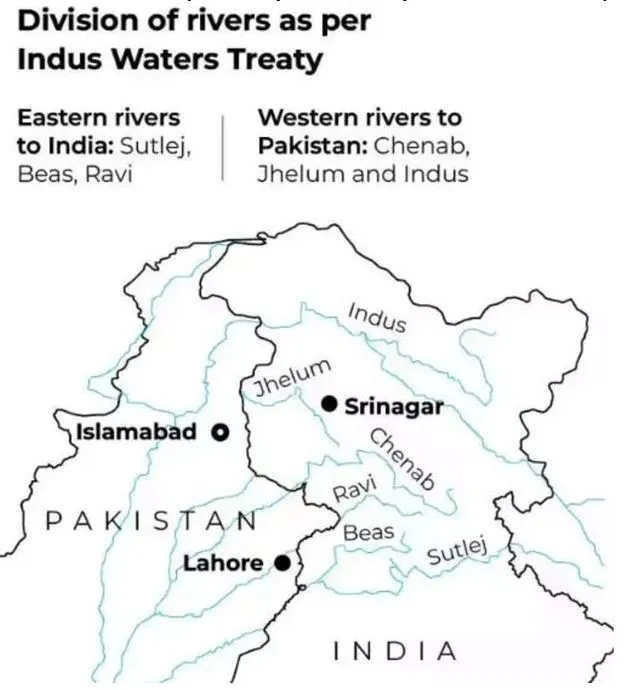
Why is this a Big Deal?
- Linking Water and Security: Until now, India has kept water diplomacy separate from security and terrorism issues. This suspension breaks that tradition — signaling that support for terrorism will now invite consequences, including on vital resources like water.
- Impact on Pakistan’s Water Security: Pakistan is heavily dependent on the Indus River system, particularly for Agriculture (90% of irrigation), Drinking water, Hydropower. Any disruption in flows, or even the fear of reduced cooperation, could:
- Exacerbate water stress, especially in Punjab and Sindh
- Reduce crop yields and impact food security
- Create internal political pressure on Pakistan’s civilian and military leadership
- Diplomatic Pressure and Global Optics: India has traditionally been seen as a responsible actor in international treaties. By choosing abeyance over abrogation, India is still upholding the legal framework, while sending a tough political signal.
“Held in Abeyance”
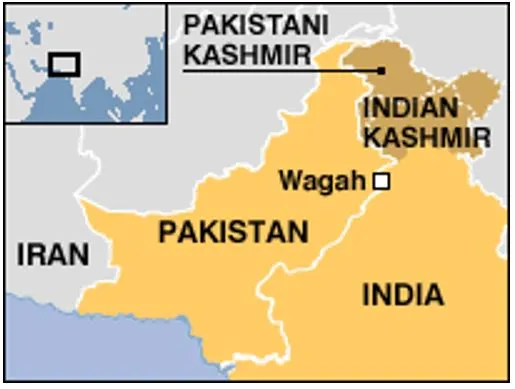 |

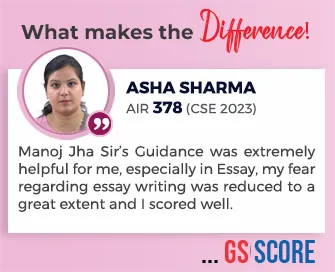
Mains Issues
Context
Prime Minister Narendra Modi visited Saudi Arabia to co-chair the second meeting of the India-Saudi Arabia Strategic Partnership Council. Modi also visited Jeddah (the first Indian Prime Minister in over 4 decades). The visit led to the signing of several Memoranda of Understanding (MoUs) and expansion of strategic cooperation, but was cut short due to a terror attack in Jammu and Kashmir’s Pahalgam.
Key-highlights of the visit:
- Strategic Partnership Council (SPC)
- The second meeting of the India–Saudi Arabia Strategic Partnership Council was co-chaired by Prime Minister Narendra Modi and Crown Prince Mohammed bin Salman in Jeddah.
- The Council reviewed progress in key sectors such as defence, energy, trade, and cultural cooperation.
- The structure of the SPC was expanded from two to four ministerial committees, with the inclusion of new committees on Defence Cooperation and Tourism and Cultural Cooperation.
- MoUs and Agreements Signed
- Space Cooperation: A Memorandum of Understanding was signed between the Saudi Space Agency and the Department of Space, Government of India.
- Health Cooperation: An MoU was signed between the Ministry of Health of Saudi Arabia and the Ministry of Health and Family Welfare, Government of India to strengthen health systems and managing public health risks.
- Anti-Doping Cooperation: A bilateral agreement was signed between the Saudi Anti-Doping Committee and India’s National Anti-Doping Agency.
- Postal Services: An MoU was signed between the Saudi Post Corporation and India Post.
- Defence and Security Cooperation
- A dedicated Ministerial Committee on Defence Cooperation was established under the Strategic Partnership Council framework.
- India and Saudi Arabia reaffirmed growing collaboration through joint military exercises such as SADA TANSEEQ and AL MOHED AL HINDI.
- A trilateral staff-level dialogue mechanism among the three armed services was initiated.
- Energy and Climate Cooperation
- Both countries agreed to work together to ensure the stability of global oil markets and improve mutual energy security.
- Joint collaboration was initiated in the areas of green hydrogen development, renewable energy technologies, and strategic petroleum reserves.
- Saudi Arabia reiterated its support for regional environmental initiatives such as the Saudi Green Initiative and the Middle East Green Initiative.
- Investment and Economic Engagement
- India and Saudi Arabia are collaborating on setting up two major refinery projects and resolving bilateral tax-related challenges.
- An “India Desk” was officially launched at the Saudi Public Investment Fund (PIF) to facilitate investor engagement.
- Both sides reaffirmed their commitment to finalizing the Bilateral Investment Treaty and initiating negotiations on the India-GCC Free Trade Agreement.
- The GCC bloc—comprising Saudi Arabia, UAE, Qatar, Kuwait, Bahrain, and Oman—represents a strategic economic zone for India.
Why Saudi Arabia is important for India?
- IMEC: Saudi Arabia sits at the heart of the IMEC corridor’s proposed land and maritime routes.
- The IMEC is a planned economic corridor that aims to bolster economic development by fostering connectivity and economic integration between Asia, the Persian Gulf and Europe.
- The corridor is a proposed route from India to Europe through the United Arab Emirates (UAE), Saudi Arabia, Israel and Greece.
- Energy: India and Saudi Arabia’s energy ties are foundational to the broader economic relationship. Saudi Arabia is a major oil supplier for India and is increasingly collaborating with India in areas like green hydrogen, refining, and petrochemicals.
- Saudi Arabia’s geographical position, investment capacity, and strategic importance give it a central role in India’s foreign policy. For India, engaging with Saudi Arabia strengthens its westward connectivity, elevates its global economic role, and helps craft a multipolar regional order.
What is the current state of India-Saudi Arabia relations?
- Diplomatic ties between India and Saudi Arabia were established in 1947.
- The relationship was elevated to a Strategic Partnership with the Delhi Declaration (2006) and Riyadh Declaration (2010) during PM Manmohan Singh’s visit.
- In 2019, PM Narendra Modi's second visit led to the formation of the Strategic Partnership Council (SPC) to institutionalize high-level engagement.
- Trade: India is Saudi Arabia’s second-largest trading partner, while Saudi Arabia is India’s fifth-largest. In FY 2023–24, bilateral trade reached USD 42.98 billion, with:
- Indian exports: USD 11.56 billion
- Indian imports: USD 31.42 billion
- Investment: Indian companies have invested approximately USD 3 billion in Saudi Arabia across IT, telecom, pharma, and construction. Saudi investments in India are led by the Public Investment Fund (PIF), with a total of USD 10 billion
- Saudi Arabia ranks 20th in FDI equity inflows into India (cumulative FDI: USD 3.22 billion, 2000–2024).
- Energy Partnership: In FY 2023–24, Saudi Arabia was:
- India’s 3rd largest source of crude oil (14.3% of total imports)
- 3rd largest supplier of LPG (18.2% of total LPG imports)
- Defence and Security Cooperation: The first joint land military exercise, EX-SADA TANSEEQ, was held in 2024.
- The bilateral naval exercise ‘Al Mohed Al Hindi’ has become a regular feature.
- The Indian community in Saudi Arabia (approx. 6 million) is the largest expatriate group, widely respected and preferred.
Fact Box: Jeddah
 |
PYQQ. Which of the following is not a member of ‘Gulf Cooperation Council’? (2016)
Solution: (a) Q. The question of India’s Energy Security constitutes the most important part of India’s economic progress. Analyse India’s energy policy cooperation with West Asian countries. (2017) |


Mains Issues
Context
The International Monetary Fund (IMF), through its World Economic Outlook (WEO) April 2025 report, has projected that India will remain the fastest-growing major economy in the world in 2025 and 2026. The growth rate is expected to be 6.2% in 2025 and 6.3% in 2026.
- This is higher than global growth, which is projected at 8% in 2025 and 3.0% in 2026.
- In contrast, China's growth is estimated at just 4% in 2025, and the US economy is expected to grow by 1.8%.
What is supporting India’s Growth?
- Strong Private Consumption, especially in rural areas, is one of the key drivers. This shows a broad-based economic recovery.
- Government reforms and public investments in infrastructure, digital connectivity, and welfare delivery have also strengthened resilience.
- India’s focus on financial inclusion, startup ecosystems, and manufacturing-led exports (like electronics and semiconductors) are beginning to pay off.
- The banking sector is relatively healthier today (lower NPAs, better credit growth), which helps finance economic activity.
What challenges Does India Face?
While the IMF outlook is positive, it's important to understand that the path ahead is not without risk:
- Global Trade Tensions: As the WEO notes, there is a rise in tariffs and trade barriers India is not immune, especially as it aspires to increase exports.
- Climate and Resource Stresses: Water stress, urban pollution, and extreme weather events may increasingly affect agriculture, health, and productivity.
- Employment Quality: While growth is high, employment generation, especially quality formal jobs, has to match the pace. Informal employment remains high.
- Fiscal Management: Sustaining growth with balanced fiscal health is a challenge. Public investment needs to be maintained without causing unsustainable debt.
IMF’s World Economic Outlook (WEO)
|


Prelims Articles
Context
The Indigenous Tribal Leaders’ Forum (ITLF) — a major organisation representing the Kuki-Zo tribal communities in Manipur — has announced that May 3 will be observed annually as ‘Separation Day’. This is to mark what they call “two years of total separation” from the Meitei community, following a violent ethnic conflict that began on May 3, 2023.
About Manipur’s Ethnic Conflict
- Ethnic Composition of Manipur: Manipur is home to multiple ethnic groups:
- Meiteis: Mostly reside in the Imphal Valley, form a majority (~53% of the population), and are predominantly Hindu.
- Kuki-Zo and Naga Tribals: Mostly live in the hill districts, are Christian by faith, and have Scheduled Tribe (ST) status.
- Triggering Incident (ST Demand by Meiteis)
- The conflict began when the Meitei community demanded Scheduled Tribe status, citing historical disadvantages.
- This was opposed by tribal communities, who feared that Meiteis — with political dominance and access to the Valley — would gain land rights in the hills, threatening tribal autonomy and land security.
- A tribal solidarity march organized on May 3, 2023, in protest against this demand led to clashes that soon spiraled into widespread violence, arson, killings, and forced displacements.
- Territorial Division: Since the outbreak of violence, Meitei and Kuki-Zo populations have remained physically separated. The ITLF’s term “total separation” reflects this de facto partition, where:
- Meiteis avoid hill areas.
- Kukis avoid the Valley.
- The idea of 'Separation Day' reflects a symbolic hardening of this division.
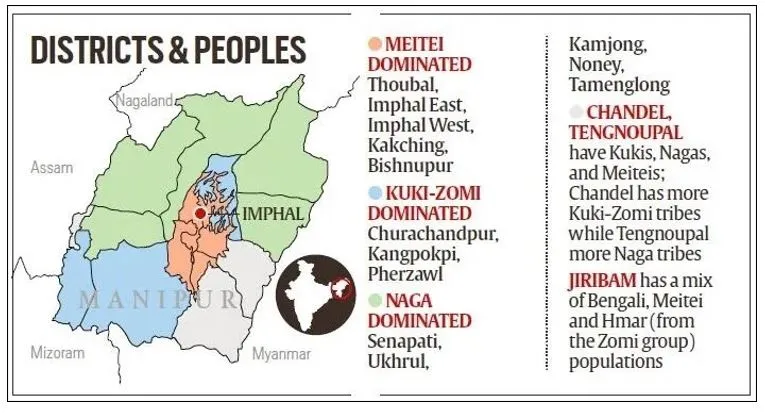


Prelims Articles
Context
The Film and Television Institute of India (FTII), Pune and the Satyajit Ray Film and Television Institute (SRFTI), Kolkata), two of India’s premier institutions for film and media education, have now been granted the status of “Institutions Deemed to be Universities” under the distinct category by the Ministry of Education, based on recommendations by the University Grants Commission (UGC). They are now recognised under Section 3 of the UGC Act, 1956, which provides the legal framework for Deemed University status.
What is a Deemed-to-be University?
- In India’s higher education system, Deemed-to-be University is a special recognition given to high-performing institutions that may not be established through legislation (like Central or State Universities), but have achieved a level of academic and research excellence in a specific domain.
- The term "Deemed-to-be University" means that the institution is considered at par with a university and enjoys full academic autonomy.
- · Key features of a Deemed-to-be University:
- Can design their own syllabus and courses tailored to their academic focus
- Conduct their own admissions and examinations
- May grant degrees (if permitted by the UGC)
- Greater flexibility in curriculum innovation and research
- Must comply with UGC regulations and NEP 2020 guidelines
How is this different from Central or State Universities?
|
Feature |
Central University |
State University |
Deemed-to-be University |
|
Established By |
Act of Parliament |
State Legislature |
Ministry of Education (on UGC advice) |
|
Funding |
Central Government |
State Government |
Autonomous (Govt + Own funds) |
|
Academic Autonomy |
High |
Moderate |
Very High |
|
Degree-Granting Power |
Yes |
Yes |
Yes (if approved) |
|
Examples |
JNU, DU |
Mumbai University, Osmania University |
BITS Pilani, IISc, FTII (now) |


Prelims Articles
Context
In recent times, several Supreme Court judgments—especially on Article 370, Article 142, and the powers of Governors—have sparked debates over judicial overreach and the balance of power among the constitutional organs. Critics argue the judiciary is encroaching upon executive and legislative functions, raising concerns over whether India is witnessing judicial despotism.
What is the issue?
- India is governed by a written Constitution, where powers are divided among three key organs—Legislature, Executive, and Judiciary. Ideally, these organs should function independently while maintaining a healthy balance.
- But in recent times, questions are being raised about whether the judiciary—especially the Supreme Court—is overstepping its limits, thus disturbing this balance.
- Terms like “judicial overreach,” “judicial activism,” and even “judicial despotism” are being used to describe the court’s interventions in matters typically under the domain of the executive or legislature.
What is Judicial Review and Judicial Activism?
- Judicial Review is the power of the constitutional courts (High Courts and Supreme Court) to examine the legality or constitutionality of legislative and executive actions.
- Though the phrase is not explicitly mentioned in the Constitution, Article 13 empowers courts to declare any law violating Fundamental Rights as void.
- Judicial Activism, on the other hand, refers to a more proactive role taken by the judiciary, sometimes stepping into governance-related areas, especially when the legislature or executive fails to act.
- It became prominent during the post-Emergency era when the Supreme Court liberalised locus standi rules and developed Public Interest Litigation (PIL) to make justice more accessible.


Prelims Articles
Context
US Vice President JD Vance urged India to drop non-tariff barriers, give greater access to its markets. Indian products too face these issues in the international markets including in America, EU, China, Japan, and Korea.
What are non-tariff barriers (NTBs) in the international trade parlance?
- Non-Tariff Barriers (NTBs) are trade restrictions that do not involve traditional taxes or tariffs on imports and exports.
- These include regulations, standards, procedures, certifications, quotas, import licensing, subsidies, testing requirements, and more.
- NTBs arise when these rules go beyond reasonable justification—they may discriminate against foreign goods, create delays, or raise costs without clear health, safety, or environmental reasoning.
- Example: An Indian fruit exporter may be required by the EU to prove compliance with specific pesticide residue standards through costly lab tests. Even a small deviation or delay in paperwork can lead to shipment rejection.
- It is essential to differentiate between non-tariff measures (NTMs) and NTBs.
- Non-Tariff Measures (NTMs) are legitimate regulations for public health, safety, and environmental protection. NTM may be
- “Technical” measures like regulations, standards, testing, certification, pre-shipment inspection
- “Non-Technical” measures like quotas, import licensing, subsidies, government procurement restrictions, etc.
- NTBs are unreasonable or opaque versions of NTMs that appear to unfairly block trade.
- Non-Tariff Measures (NTMs) are legitimate regulations for public health, safety, and environmental protection. NTM may be


Prelims Articles
Context
Earth Day, celebrated every year on April 22, is one of the most widely observed global events focused on environmental protection and raising awareness about the growing threats to our planet. The theme for 2025 is “Our Power, Our Planet”, and it highlights a crucial global priority: the transition to clean, renewable energy.
About Earth Day
- Earth Day was first celebrated in 1970 in the United States. The day is also known as International Mother Earth Day.
- The idea came from Senator Gaylord Nelson and was organized with the help of Denis Hayes, a young student activist.
- They chose April 22 as the date because it fell between Spring Break and final exams, helping to attract maximum participation from students.
- This year, Earth Day marks its 55th anniversary with global activations aimed at mobilising a billion people worldwide to take transformative action for our planet for a sustainable future.
- India’s Sustainable Policy Shifts
- COP26 and Panchamrit Goals: India announced a five-point climate agenda at COP26, including net-zero emissions by 2070 and 50% renewable energy by 2030.
- Solar and Electric Push: With the International Solar Alliance and missions like PM-KUSUM, India is leading solar growth. FAME and Indian Railways’ net-zero target by 2030 support clean mobility.
- Conservation and Legal Progress: Wildlife conservation efforts like Project Tiger, NCAP for air quality, and legal frameworks for e-waste and plastic management have strengthened ecological governance.
Key-Initiatives for Environment Conservation
|


Prelims Articles
Context
In the aftermath of the Pahalgam terror attack in Jammu and Kashmir, the Indian Army has now permitted limited flying of the Dhruv fleet, but only for critical counter-terror operations.
What is the Dhruv Helicopter?
- The Advanced Light Helicopter (ALH) Dhruv is an indigenously designed and developed multi-role helicopter produced by Hindustan Aeronautics Limited (HAL).
- It is a flagship platform under India’s push for self-reliance in defence manufacturing.
- Class: 5.5-tonne weight category
- Type: Twin-engine, multi-role, multi-mission
- Users: Indian Army, Air Force, Navy, Coast Guard, and several foreign militaries and civil users.
- It is used for a wide range of purposes — from logistics and surveillance to casualty evacuation, reconnaissance, anti-terror ops, disaster relief, and maritime roles.
- Design and Features
- It is developed by HAL’s Rotary Wing Research and Design Centre (RWR&DC).
- It is designed for both high-altitude and all-weather operations — crucial for missions in Himalayan and border regions.
- It can carry troops, weapons, sensors, or equipment depending on configuration.
- Key versions include:
- ALH Mk I/II – Early models, utility variants.
- ALH Mk III – Improved avionics and systems.
- ALH Mk IV (Rudra) – Armed variant with weapon systems for combat.

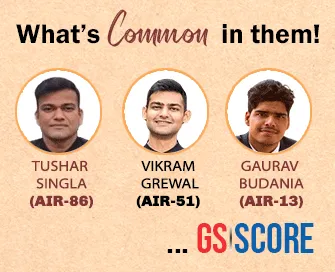
Editorials
Context
A terror attack in Pahalgam, Jammu and Kashmir, claimed the lives of 26 tourists, marking a strategically timed escalation by a Pakistan-backed proxy group, The Resistance Front, amidst rising tourism and the U.S. Vice President's visit to India. The act has reignited debates around India’s deterrence policy, cross-border terrorism, and Pakistan’s destabilising military posture.
Strategic Intent and Tactical Calculations
- Political Signal, Not Just Violence: The Pahalgam attack was a deliberate disruption of strategic normalcy in Kashmir, aimed at undermining the tourism-driven narrative of peace and progress, while also seeking to regain relevance for Pakistan in India’s foreign policy radar.
- Targeted Symbolism in Site Selection: The attack on Baisaran (nicknamed "Mini Switzerland"), a tourist haven near the Amarnath route, sought to psychologically scar the image of Kashmir as safe, using civilian deaths to sabotage a growing economy of peace.
- Institutional Lapses in Security Apparatus: Despite heavy investments in surveillance and counter-terrorism infrastructure, there was a glaring intelligence failure in a known high-value target area, revealing serious vigilance and coordination lapses among security agencies.
Pakistan’s Escalatory Doctrine and Role of ISI
- Proxy Warfare and Strategic Deniability: The Resistance Front, operationally linked to Lashkar-e-Taiba and backed by Pakistan’s Inter-Services Intelligence (ISI), continues the doctrine of deniable escalation — calculated attacks below the nuclear threshold while avoiding direct attribution.
- Internal Instability Driving External Aggression: Pakistan’s economic collapse and political dysfunction have historically triggered outward adventurism in Kashmir, used by the military to consolidate control and divert domestic dissent, as seen in past events like Kargil (1999) and Pulwama (2019).
- Role of General Asim Munir’s Aggressive Doctrine: Current Pakistani Army Chief General Asim Munir, former ISI head, has revived managed escalation rhetoric, with ceasefire violations and ideological posturing marking a return to a strategy that views Kashmir not as a peace project but as a tool for strategic leverage.
India’s Strategic Response and Policy Outlook
- Embrace Escalatory Credibility, Not Hesitation: India must adopt a policy of credible, calibrated deterrence through diplomatic isolation, economic leverage (e.g., Indus Waters Treaty), and covert operations — not as revenge, but as a sustained strategy to raise the cost of terrorism.
- Long-term Deterrence over Episodic Retaliation: Rather than reactive strikes, India must develop institutional continuity and bipartisan consensus in counter-terrorism policy, ensuring strategic patience and persistent diplomatic pressure that outlasts election cycles or international distractions.
- Integrating Internal Security with Public Trust: India’s internal approach should focus on economic integration, youth opportunities, and social cohesion in Kashmir. Framing Kashmiris as victims, not collaborators, is crucial for defeating the narrative-driven ecosystem that terrorist groups exploit.
Q. Discuss the concept of ‘Escalatory Credibility’ in the context of cross-border terrorism in Jammu and Kashmir. How can India balance deterrence with diplomatic and internal coherence in its counter-terrorism strategy?


Editorials
Context
U.S. Vice-President J.D. Vance’s first visit to India was overshadowed by the Pahalgam terror attacks, but his messages of solidarity and continued family visit were noted positively in New Delhi. This was the first visit by a U.S. Vice-President in 12 years, since Joe Biden's 2013 visit.
Diplomatic and Strategic Engagements
- Limited Outcomes from High-Level Talks: Vance-Modi Meeting – The talks during the visit did not result in major breakthroughs but led to finalisation of terms of reference for the Bilateral Trade Agreement (BTA) currently under negotiation in Washington.
- Forward Look to Future U.S.-India Ties: Upcoming Quad Summit – Discussions included preparations for President Trump’s planned visit to India for the Quad Summit and broader coordination on Indo-Pacific strategy.
- Nature of the Visit: Largely Private, Yet Strategic – Though termed a “largely private” trip, the Vice-President's tour of Delhi, Agra, and Jaipur with his Indian-origin family served as a soft diplomacy tool and cultural outreach.
Trade and Economic Concerns
- S. Perspective on Trade Policies: Rebalancing, Not War – Vance defended Trump's economic stance, stating the administration does not seek a “trade war” but aims to “rebalance global trade”, with the BTA projected as a “final deal” for fairness.
- S. Demands on Market Access: Non-Tariff Barriers in India – He urged India to remove non-tariff barriers, especially those hindering U.S. dairy and agricultural exports, a highly sensitive domain in Indian trade policy.
- Fossil Fuels and Energy Security: “Drill, Baby, Drill” Policy – Vance promoted U.S. fossil fuel exports under Trump’s energy policy, suggesting India would benefit from increased imports of American oil and natural gas.
Defence and Regulatory Issues
- Defence Cooperation Offers: Co-Production and Jet Sales – Vance reaffirmed India as a trusted defence partner, offering F-35 fighter jets and boosting co-production of defence hardware.
- Nuclear Liability Law Concerns: Regulatory Hurdles – He emphasised the need for amendments to India’s nuclear liability laws to facilitate S. nuclear companies’ entry into India’s civilian nuclear energy sector.
- Immigration and Visa Policy Issues: Student Visa Revocations – Though not publicly raised by Modi, revocation of visas affecting hundreds of foreign students, with Indians being a majority, remains a critical concern in bilateral ties.
Practice Question:
Q. What do you understand by a trade barrier? What is the difference between tariff and non-tariff barriers?


Editorials
Context
India continues to face serious challenges related to food adulteration and poor nutrition, with rising concerns over public health, food safety enforcement, and global reputation—especially after recent international bans on Indian spice exports due to contamination.
Nutrition and Health Challenges
- Poor Nutritional Outcomes in Children: NFHS-5 Data Highlights – As per NFHS-5 (2019–21), stunting affects 5%, wasting 19.3%, and underweight prevalence is 32.1% in children under five, reflecting persistent nutritional deprivation.
- Policy Influences Beyond Health: Political vs Nutritional Priorities – Government food programs like mid-day meals are often shaped more by social and political narratives than by actual health or dietary needs.
- Widespread Public Apathy: Neglect of Adulteration Issues – Despite long-standing issues such as milk adulteration, there is limited public outrage, indicating normalisation of food safety violations.
Scale and Types of Adulteration
- Persistent Milk Adulteration: Survey Evidence – As per a 2011 national survey, 70% of milk samples were found adulterated, with water, salt, detergents, and glucose being major contaminants.
- Adulteration of Everyday Foods: Fake Paneer and Contaminated Fruits – Items like paneer, watermelon, and spices are increasingly adulterated with substances like starch, synthetic milk, detergents, raising acute health risks.
- Oil and Spices: High-Risk Categories: Cancer-Linked Additives and Bans – Edible oils are adulterated with argemone and rice bran oil; ethylene oxide in spices led to bans by Hong Kong and EU, tarnishing India's culinary exports and soft power.
Institutional Response and Gaps
- FSSAI Measures and Limitations: Enforcement and Consumer Awareness – Though FSSAI conducts raids and cancels licences, the burden is shifted to individual vigilance, which is ineffective for the poor and uneducated.
- Structural and Capacity Issues: Inadequate State Infrastructure – Many states lack proper enforcement mechanisms, calling for better food monitoring infrastructure and harmonised national standards.
- Need for Systemic Reform: Food Literacy and Safe Practices – There is an urgent need for training producers, better food processing, and redefining permissible chemical levels, alongside promoting food literacy for long-term impact.
Practice Question:
Q. India’s struggle with food adulteration reflects deep structural issues in its food governance ecosystem. Critically examine the link between food safety, public health, and regulatory capacity in India. Suggest long-term solutions for ensuring food security beyond nutrition.



